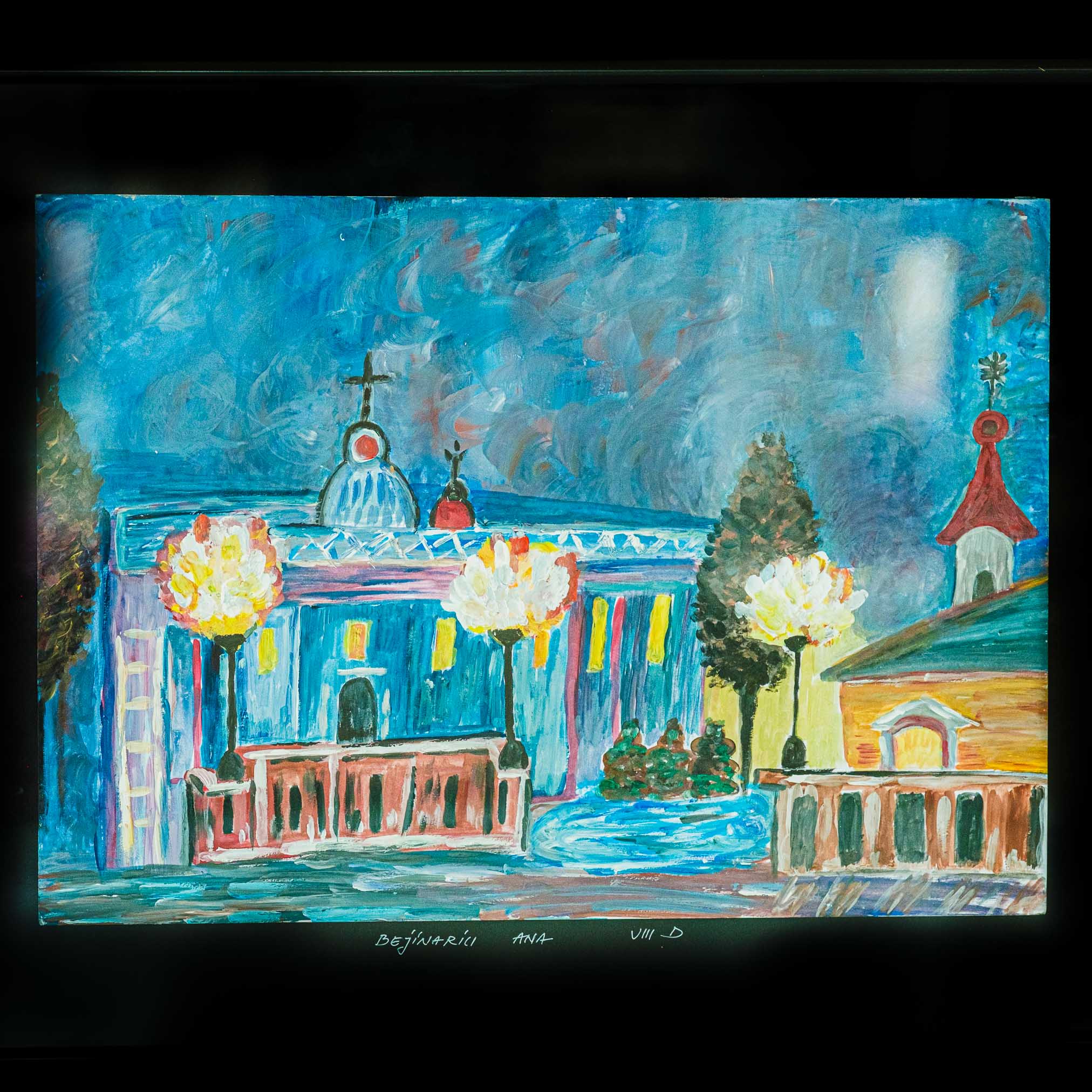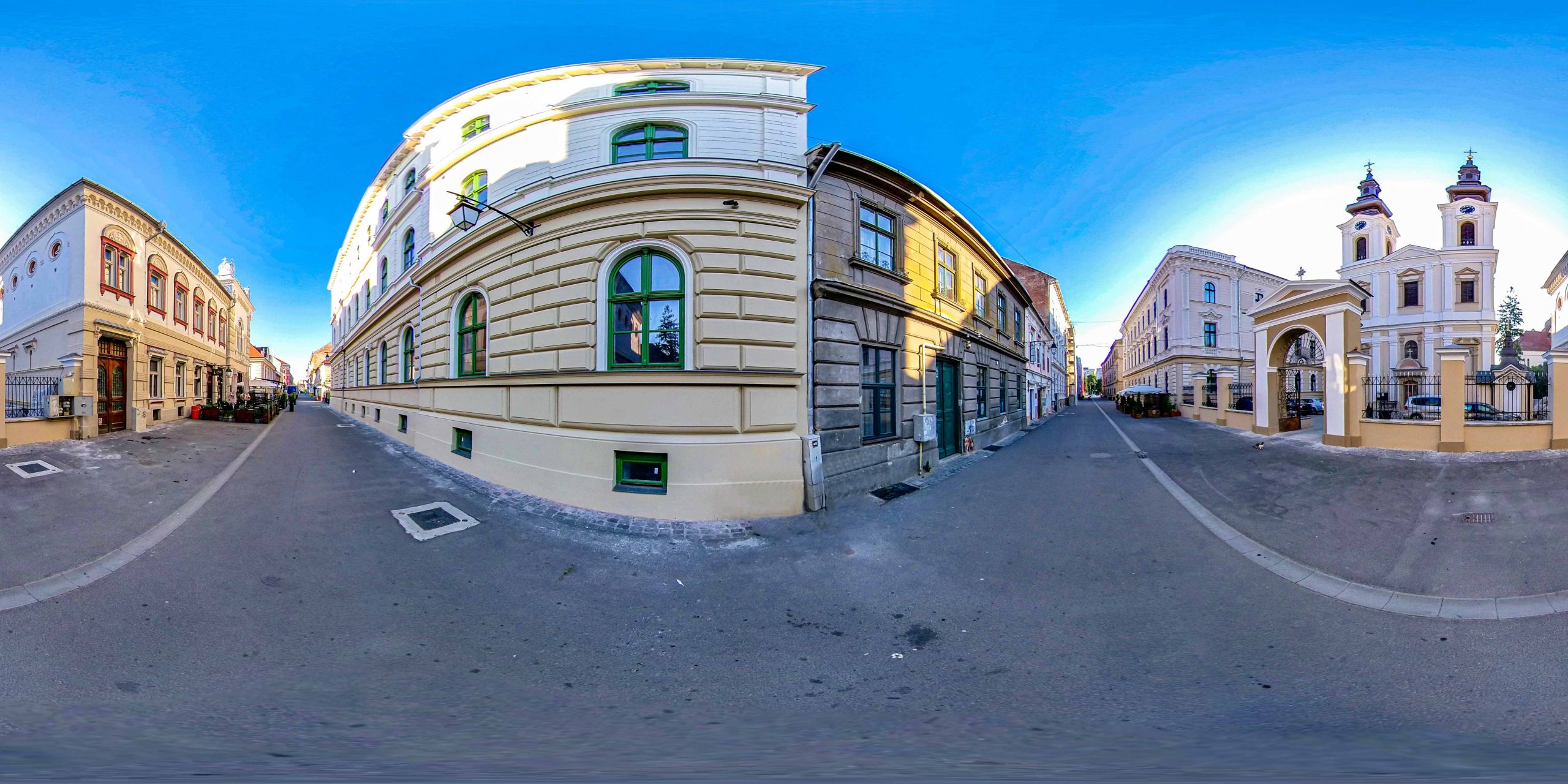The Episcopal Palace, currently the seat of the Serbian Orthodox Episcopate of Timisoara, was built in parallel with the Serbian Orthodox Cathedral, between 1745-1748.
Listen to the audio version.
The Orthodox bishops of Timișoara had, since the period of Ottoman rule, their own headquarters and a church with the rank of the cathedral, but the two buildings were destroyed during the fire of 1737, a fire that burned the entire fortress down.
The new Episcopal Palace, currently the seat of the Serbian Orthodox Episcopate of Timisoara, was built in parallel with the Serbian Orthodox Cathedral, between 1745-1748, during the time of Metropolitan Georgije Popović.
The bishop's palace in the mid-18th century had a different appearance from today, being built in the Baroque style, with the south wing partially built, with only the facade on the east side completed. During the 19th century several stages of construction took place, with the south wing being completed and the west wing built from the foundations.
The most extensive interventions on this Baroque edifice took place at the beginning of the 20th century, during the time of Bishop Georgije Letić. According to the project of the Timișoara architect László Székelythe palace underwent major modifications, completed in October 1906.
The Serbian Orthodox Cathedral dedicated to the Ascension of the Lord was built in parallel with the Episcopal Palace, being completed in 1748, as evidenced by an inscription kept inside the building. Made in the Baroque style, the church has generally retained its original shape in the 18th century.
In the first half of the 19th century, important works were undertaken inside the church, the new iconostasis being made by the sculptor Mihajlo Janić and the painter Constantin Daniel (also known as Tiziano from Banat).
Until the middle of the 19th century, the church was used by the entire Orthodox community in Timișoara-Cetate, and after the hierarchical separation, it remained the property of the Serbian community.
Bibliography:
- Stevan Bugarski, Ljubomir Stepanov, Srbi u Temišvaru - GradSavez Srba u Rumuniji, Temišvar, 2011, pp. 126-127; 149-163.
- Stevan Bugarski, Srpsko pravoslavlje u RumunijiTemišvar-Beograd-Novi Sad, 1995, pp. 152-157.
Serbian Orthodox Cathedral and the Episcopate
Listen to the audio version.
"“Today I listened to a ‘Gospodi pomilui’ at the Serbian churchThe most beautiful service and choir I have heard around here, and even the inside is nicer than their church in the center. A sweet and smiling Saint George fights with a dragon, playing and having fun, as if wrestling with a dog.” (Cora Irineu, Letters from Banat, Published and Printed by Cultura Națională, Bucharest, 1924, p. 6)
On the western side of Union Square, facing the Cathedral, there is the episcopal church and the Palace of the Serbian Orthodox Diocese. The first constructions of the Orthodox parish were destroyed, because of 1728 fire. After this calamity, up until 1745, there was only one house of prayer in this quarter of the city. When the metropolitan of Niš, Gheorghe Popovici, became the bishop of the Orthodox church in Timişoara, he built, with the help of donations, between the years 1745-1748, the church, at first without towers, and then the episcopal residence. This complex existed before the Roman Catholic Cathedral. In 1791, when the church was restored under Bishop Petru Petrovici, it was completed with the two towers in which the five bells are located, one of which weighs 800 kg. The church was used jointly by the Romanian and Serbian Orthodox believers until the middle of the 19th century, when the two churches separated.
In 1906, bishop Dr. Gheorghe Letici initiated a thorough renovation of the church and the episcopal palace, a new building being built at the same time. The iconostasis of the church is the work of the wood sculptor Mihailo Ianici. Many of the icons of the church are the work of Timisoara painter Constantin Daniel. On August 24, 1964, the church was declared a historical monument. The facade of the episcopal palace is dominated by a balcony and the episcopal coat of arms located on the tall frontispiece of the building. Inside, we can visit the Serbian Orthodox Vicarage and the Museum of the Serbian Diocese, where objects from the monasteries and churches of Ciacova, Sânpetru Mare, Ivanca, Foeni, Petrovaselo and Bezdin can also be admired. The collection is completed by a significant number of engravings, some of which belong to Zaharia Stefanovici Orfelini.
Else von Schuster (b. 1925 ) interviewed by Adrian Onică in 2000 and 2001 in Timisoara (Third European Archive, BCUT)
Nenadovici fragment Here the picture of the choir of the Bishopric 1923
(Tell me about the Serbian church choir) In the period between the two world wars, the Serbs had three church choirs in Timisoara, one of which was from the Cathedral in Piaţa Unirii (in the picture we can see the whole choir, with all the leadership, with the president, vice-president, including my father - he can also be seen in the photograph) and there were two other choirs, also from the church: one in the Fabric district, at the church in Piaţa Traian, and one in Mehala. Apart from attending the liturgy every Sunday, they also had concerts outside the church, and the two choirs, the one from the Cetate, the Cathedral and the one from Fabric, were in Yugoslavia on tours and even at competitions between church choirs. (How long did these choirs exist?) These choirs existed until the start of the war, that is, until '41. There was an impressive number of people in the choir (as can be seen in the photo) and then this number decreased and disappeared with the advent of communism, in '44-'45. Then it was re-established. Some were afraid to participate. A church choir was made, I'm talking about the one from the Cetate, of the Cathedral. Then only a male choir was established, with a very limited number of 16-18 people. It was initially a mixed choir.
After '44-'45, when the communist terror was more and more accentuated and there were plenty of anti-religious demonstrations going on, pressures, people were employed in various places, so they were afraid to attend the religious service every Sunday. They also had rehearsals 2-3 times a week and that was considered as something subversive by the communist authorities, so there was a period when it didn't work at all. Then it started as a male choir, of which my father was no longer a part, because he was already ill and could no longer go to this choir. Then it was completely abolished. The re-establishment of a Serbian choir of the Cathedral was done after 1990 and it is now a very strong and qualitatively realized choir..
(Where were the rehearsals held back then?)The rehearsals were held in the building next to the church, to the left of the church, the one that belongs to the Serbian church in Cetate, in a hall where the priests' residence was - the priests' meeting room. There was a rather large room where these rehearsals took place.
(…) Were there any clubs or places where Serbs met? Yes, for example, when the Cetate choir had a rehearsal in the evening, they would go to the Şpidu restaurant, where the Museum of the Revolution can be found today ( it was in 2003 - n.n.) on Gheorghe Lazăr Street. If there were men in the choir then the wives were already waiting there or vice versa.
Excerpt of the interview conducted by Onica Adrian with Nenadovici Vladimir (b.1923), interviewed by Adrian Onica in February 2003, Timisoara (Third European Archive, BCUT)

Artwork by Alexandru_Taralesca, student in class VIII E a General School No 19 "Avram Iancu" and exposed to UPT Library within the exhibition "Timisoara's Stories - A Visual Journey through Timisoara" - within the Creative Schools Project - Timisoara's Stories - a continuation of the Spotlight Heritage Timisoara project, part of the cultural program of the Timisoara Cultural Capital 2023 - project that brought together over 1600 children and teenagers and more than 60 teachers from Timisoara's schools, in over 50 interactive activities.

Artwork by Ana Bejinariu, 8th grade D student General School No 19 "Avram Iancu" and exposed to UPT Library within the exhibition "Timisoara's Stories - A Visual Journey through Timisoara" - within the Creative Schools Project - Timisoara's Stories - a continuation of the Spotlight Heritage Timisoara project, part of the cultural program of the Timisoara Cultural Capital 2023 - project that brought together over 1600 children and teenagers and more than 60 teachers from Timisoara's schools, in over 50 interactive activities.












































